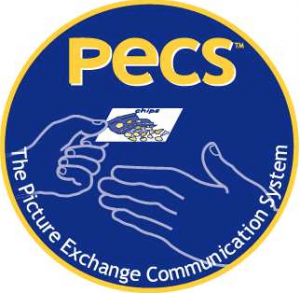The Picture Exchange Communication System, or PECS, is an AAC system that aims to focus on the initiation component of communication.
Download: Picture Exchange Communication System (PECS)
Background:  The Picture Exchange Communication System, or PECS, is an AAC system that was originally created for preschool children with Autism Spectrum Disorder (ASD) and other related communication disorders, but it can be used among individuals of all ages with a variety of communication disorders. PECS was developed in 1985 by. The creators based the PECS teaching protocol on B.F. Skinner’s book, Verbal Behavior, such that functional verbal operants are systematically taught using prompting and reinforcement strategies that will lead to independent communication. Verbal prompts are not used, thus building immediate initiation and avoiding prompt dependency.
The Picture Exchange Communication System, or PECS, is an AAC system that was originally created for preschool children with Autism Spectrum Disorder (ASD) and other related communication disorders, but it can be used among individuals of all ages with a variety of communication disorders. PECS was developed in 1985 by. The creators based the PECS teaching protocol on B.F. Skinner’s book, Verbal Behavior, such that functional verbal operants are systematically taught using prompting and reinforcement strategies that will lead to independent communication. Verbal prompts are not used, thus building immediate initiation and avoiding prompt dependency.
Population: Individuals of all ages
- Autism Spectrum Disorders
- Other communication disorders
Description: PECS is a six step system for encouraging individuals to communicate through pictures with those around them. The first steps involve teaching the individual how to request a highly preferred item with a picture. Later steps expand the student’s picture “vocabulary” and encourage initiation of communication with others. Final steps add linguistic structure to the child’s picture sentences and allow for conversations with communication partners. The ultimate goal of PECS is for individuals using it to initiate functional communication across all settings with a variety of people. PECS is based on principles of ABA and was influenced by B.F. Skinner’s 1957 book, Verbal Behavior.
Before beginning PECS
- Assess student’s communication skills
- Organize the environment for appropriate training
- Select a reinforcer
- Using parent/caretaker interview, student observations, formal assessments to create a reinforcement hierarchy
- Prepare materials:
- Picture icons (can be photographs, digital images, drawings, etc.)
- Communication binder (with Velcro®)
- Sentence strip
- Tangible reinforcers
Cost:
- Minimal cost for materials (Velcro®, binder, icons).
- Trainings (Level 1 and Level 2) are $400 for professionals and $300 for parents.
Strengths:
- Can be used with a variety of communicative partners (peers included)
- Can be used in any environment and throughout the classroom.
- Builds functional/social communication.
- Relatively inexpensive.
- Can transition to technology.
Weaknesses:
- Creating and teaching the program is time consuming and labor intensive because books are individualized for each student.
- Requires two staff members – may be a drain on resources.
- Food may be most effective and available reinforcer (Health issues).
- Primarily used for requests – only Phase VI concerns commenting.
- Trainings are at least two days long and cost about $400 for professionals.
Additional Information:
- Some studies have shown small to moderate increases in communication among children with Autism Spectrum Disorders
- It is NOT a tool to elicit speech production
Find other Contemporary Approaches to Intervention here!
Special thanks to Katie Mosher, Galadriel Sevener, Lauren Alpert and Andrew Angeles.
Sources:
Flippin, M., Reszka, S., & Watson, L. (2010). Effectiveness of the picture exchange communication system (PECS) on communication and speech for children with autism spectrum disorders: A meta-analysis. American Journal of Speech-Lang Pathology, 19(2), 178-195.
Frost, L., & Bondy, A. (2002). The picture exchange communication system training manual (2nd ed.). Newark, Delaware: Pyramid Educational Consultants. PECS-USA (n.d.). Retrieved from http://www.pecsusa.com
Schlosser, R., and Wednt, O. (2008). Effects of augmentative and alternative communication intervention on speech production in children with autism: A systematic review. American Journal of Speech-Language Pathology, 17(3), 212-230.

![[feed link]](/wp-content/plugins/rss-just-better/rss-cube.gif)